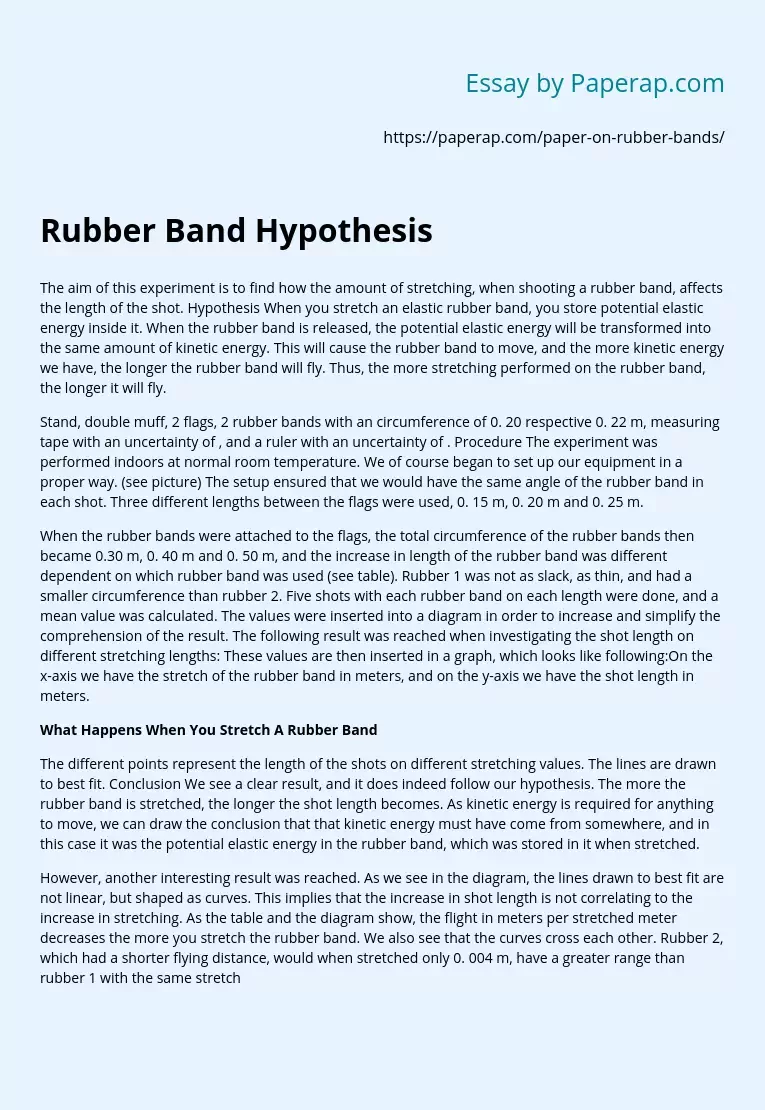Rubber Band Hypothesis
The aim of this experiment is to find how the amount of stretching, when shooting a rubber band, affects the length of the shot. Hypothesis When you stretch an elastic rubber band, you store potential elastic energy inside it. When the rubber band is released, the potential elastic energy will be transformed into the same amount of kinetic energy. This will cause the rubber band to move, and the more kinetic energy we have, the longer the rubber band will fly.
Thus, the more stretching performed on the rubber band, the longer it will fly.
Stand, double muff, 2 flags, 2 rubber bands with an circumference of 0. 20 respective 0. 22 m, measuring tape with an uncertainty of , and a ruler with an uncertainty of . Procedure The experiment was performed indoors at normal room temperature. We of course began to set up our equipment in a proper way. (see picture) The setup ensured that we would have the same angle of the rubber band in each shot.
Three different lengths between the flags were used, 0. 15 m, 0. 20 m and 0. 25 m.
When the rubber bands were attached to the flags, the total circumference of the rubber bands then became 0.30 m, 0. 40 m and 0. 50 m, and the increase in length of the rubber band was different dependent on which rubber band was used (see table). Rubber 1 was not as slack, as thin, and had a smaller circumference than rubber 2. Five shots with each rubber band on each length were done, and a mean value was calculated. The values were inserted into a diagram in order to increase and simplify the comprehension of the result.
The following result was reached when investigating the shot length on different stretching lengths: These values are then inserted in a graph, which looks like following:On the x-axis we have the stretch of the rubber band in meters, and on the y-axis we have the shot length in meters.
What Happens When You Stretch A Rubber Band
The different points represent the length of the shots on different stretching values. The lines are drawn to best fit. Conclusion We see a clear result, and it does indeed follow our hypothesis. The more the rubber band is stretched, the longer the shot length becomes. As kinetic energy is required for anything to move, we can draw the conclusion that that kinetic energy must have come from somewhere, and in this case it was the potential elastic energy in the rubber band, which was stored in it when stretched.
However, another interesting result was reached. As we see in the diagram, the lines drawn to best fit are not linear, but shaped as curves. This implies that the increase in shot length is not correlating to the increase in stretching. As the table and the diagram show, the flight in meters per stretched meter decreases the more you stretch the rubber band. We also see that the curves cross each other. Rubber 2, which had a shorter flying distance, would when stretched only 0. 004 m, have a greater range than rubber 1 with the same stretching.
This low value of stretching of course is quite hard to measure as you probably would not have been able to release the rubber band at all. Perhaps if you would have used rubber bands in a larger scale and with some differentiating property, a difference would have been possible to actually measure. However, to draw any conclusion like this from the graph probably should not be done. Our measuring points are nowhere close to the actual crossing of the lines, but at least a hint about what might happen is given, even though we can not draw any certain conclusions.
Rubber Band Hypothesis. (2019, Dec 05). Retrieved from https://paperap.com/paper-on-rubber-bands/

